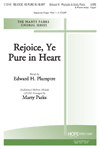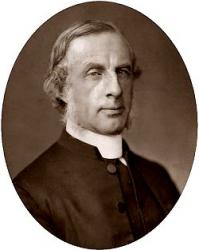In this text the imagery of a liturgical procession becomes a marching metaphor for the journey of life. The call to "rejoice, give thanks and sing" (st. 1) is extended to all people, "bright youth and snow-crowned age, both men and women" (st. 2), and on all occasions, "by night and day, in gladness and in woe" (st. 3). Life's pilgrimage has a specific goal, to be at rest in the new Jerusalem (st. 4) where all God's creatures will join in a great doxology (st. 5). The "rejoice" theme in the refrain is borrowed from Philippians 4:4.
Scripture References:
st. 2 = Ps. 40:3
ref. = Phil. 4:4
Anglican clergyman Edward H. Plumptre (PHH 363) wrote this text for use as a processional hymn for the annual choral festival at Peterborough Cathedral, England (May 1865). "Rejoice, a Pure in Heart" was originally in eleven stanzas-long enough for all the choirs to process into the cathedral. It was published in the third edition of Plumptre's Lazarus and Other Poems (1868) and in the Appendix to Hymns Ancient and Modern (1868). Of the original eleven stanzas, 1,2,8,9, and 11 are included.
In this text the imagery of a liturgical procession becomes a marching metaphor for the journey of life. The call to "rejoice, give thanks and sing" (st. 1) is extended to all people, "bright youth and snow-crowned age, both men and women" (st. 2), and on all occasions, "by night and day, in gladness and in woe" (st. 3). Life's pilgrimage has a specific goal, to be at rest in the new Jerusalem (st. 4) where all God's creatures will join in a great doxology (st. 5). The "rejoice" theme in the refrain is borrowed from Philippians 4:4.
Liturgical Use:
As a processional or recessional hymn for festive occasions; the "pilgrimage" theme may be suitable for Old/New Year services and for funerals.
--Psalter Hymnal Handbook
Hymnary Pro Subscribers
Access
an additional article
on the Canterbury Dictionary of Hymnology:
Hymnary Pro subscribers have full access to the Canterbury Dictionary of Hymnology.
Subscribe now


 My Starred Hymns
My Starred Hymns








